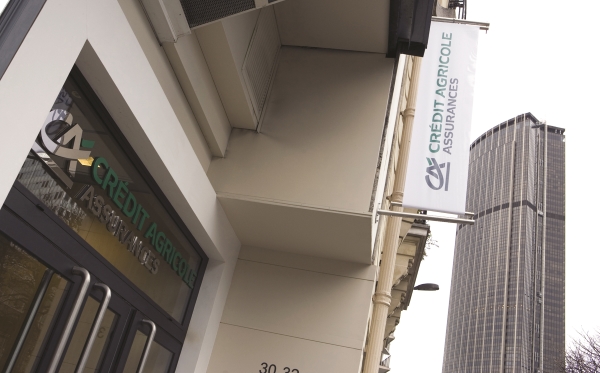CAA message, reopener resonate with investors
Crédit Agricole Assurances opened the euro insurance sub debt market for 2018 with a EUR1bn 30NC10 Tier 2 issue that attracted over EUR5bn of demand on 22 January. Crédit Agricole Assurances (CAA) CFO Clément Michaud and Crédit Agricole CIB’s Bernard du Boislouveau and Vincent Hoarau explain the background to the transaction and how it demonstrated momentum in a market where investors are hungry for supply.
As the new Crédit Agricole Assurances CFO, could you give us an overview of CAA in its market and within the Crédit Agricole Group?
Clément Michaud, Crédit Agricole Assurances: Crédit Agricole Assurances, 100% owned by Crédit Agricole SA (CASA), is a fully-fledged and diversified insurer, operating in savings and retirement, personal protection and property and casualty. CAA is a key player in the European insurance market: France’s and Europe’s leading bankinsurance group, the largest insurer in France, and the eighth largest in Europe.
Its model is based on a high integration within Crédit Agricole Group, notably to benefit from the strength of Crédit Agricole Group’s retail banking networks, mainly in France, Italy and Poland.
Insurance activities are core businesses for Crédit Agricole Group and its universal customer-focused retail banking model. And, as disclosed in the updated Medium Term Plan of the group, the ambition is to continue developing this successful bankinsurance model in the coming years.
What is the rationale for this latest subordinated transaction?
Michaud, CAA: Until 2014, CAA’s funding was wholly provided by Crédit Agricole SA. We have since then decided to change this policy to look for external hybrid funding for structural reasons, but also in connection with changes in the prudential framework and in S&P’s methodology. The new issue was hence done for refinancing purposes, replacing Tier 2 from CASA.
Regarding the timing, the market backdrop was also conducive to issuance.
Why did you decide to go for a Tier 2-style, 30NC10?
Michaud, CAA (pictured): We decided to opt for an S&P-compliant structure, in line with the previous transactions. The structure is substantially similar to euro dated callable Solvency II Tier 2 securities issued by other European insurance companies.
The maturity is driven by our wish to create a curve and to manage our debt profile. We did not have any specific reason to go further along the curve.
What was focused on during the roadshow and how was the feedback?
Michaud, CAA: There were some questions about the subordinated notes, but it was more a question of explaining developments at CAA — its most recent figures and its strong credit profile. Our feeling was that investors were well aware of the group structure — as an infrequent issuer but part of a leading bankinsurance group — and we no longer needed to present CAA in such depth.
However, we had already issued almost EUR3bn of debt and most of the investors already have some CAA bonds in their portfolios, so people expect some kind of follow-up where we can explain how we have been developing before adding to their CAA holdings. We also held an insurance workshop in November where we had the opportunity to re-explain the business model within Crédit Agricole Group and within the European insurance market, and the fact that we did that a couple of months ahead of the roadshow and new issue was positively received by investors.
The two key messages that we had regarding CAA’s development is that it is diversifying and that we have improved our solvency ratios. We are more diversified than ever and that development is accelerating. We also elaborated a lot on the disciplined risk and capital management we implement within CAA, especially in the context of low interest rates.
Bernard du Boislouveau, FI DCM, Crédit Agricole CIB: We spent three days on the roadshow and I think it was very useful to go and see investors face to face in order to explain directly the deal rationale, the issuer’s updated credit matrix, and more globally the strategy of CAA. It is always very interesting for the issuer to get the thoughts of these key investors and to understand how they assess the credit profile compared to their peers.
Overall, I do believe that investors had a positive image of CAA and of Crédit Agricole’s integrated bankinsurance model, and that this is well understood.
The market opened strongly in the first weeks of the year. However, there were some noises out of the US ahead of your deal. How did you feel about sentiment when approaching the market and did the deal ultimately go according to your expectations?
Michaud, CAA: We checked the market and from what we could see out of Asia, the US shutdown didn’t seem to be an issue, which is why we decided to move ahead — on top of the positive feedback we had received beforehand. And when we look at the order book, which was extremely large, we think that it was a very good decision.
Du Boislouveau, CACIB: Comparing this transaction with their last, in September 2016, I can only highlight the number of orders gathered, at 275 — versus 160 previously — and the global size of the order book above EUR5bn. The book comprised a very impressive 84% distribution to real money accounts, thereby achieving the kind of quality that was one of the issuer’s targets, as well as pan-European placement, with distribution extremely well spread across Europe on top of the UK bid and strong domestic placement. The marketing efforts have clearly paid off and the signature is much better understood.
The spread achieved and subsequently the extremely limited new issue concession also vindicated their strategy when going ahead with the transaction.
We adopted a consensual approach to pricing, considering that CAA’s credit profile was certainly very well received by investors but also that the continuous performance in the subordinated market was driving investors in a search for value. We definitely had to take this into account.
At the end, the positive market feedback and the strong demand for the deal enabled us to price a benchmark transaction in good market conditions at the tight end of guidance. We launched a EUR1bn 30YR NC10 at 165bp over mid-swaps, tightening the pricing by 20bp on the back of a book around EUR5bn. The new issue concession was around 5bp.
Vincent Hoarau, head of FIG syndicate, CACIB: Investors had been giving us indications of interest in the high 100s, in the context of 175bp up to 200bp over, taking into account where CAA was trading in the secondary market the previous week. There is an accumulation of cash in the market, meanwhile the Tier 2 Solvency II space is pretty much en vogue, so we had the feeling that an appropriate starting point would be in the context of 185bp-190bp, with a view to tightening the pricing something like 20bp – this is precisely what Talanx, which is a good reference for CAA, did in November. We knew we would have the option to bring the deal tighter, in the 160bp-170bp range, which would be very close to where the main CAA outstandings were trading — the September 2048s callable September 2028 were quoted in the context of mid-swaps plus 160bp when we opened books. Landing at 165bp, the new issue premium of 5bp is a very competitive result.
Then with the subsequent resolution of the US situation overnight — which was quite a surprise and not necessarily foreseeable beforehand — the market opened on a very strong note and the whole market was driven tighter the next morning. As the most recent reference, CAA benefitted the most from the situation, and was trading something like a full point higher the next day, while the main reference pre-bookbuilding, the September 2048s, were also around 15bp tighter, so this new transaction was beneficial to the whole space. In some particular situations the primary market tends to reprice the secondary market, and this is precisely what is happened here.
What should the market anticipate from CAA going forward? Will we see CAA in Tier 3 or RT1?
Michaud, CAA: CAA will remain a quite rare issuer, and we will most probably follow the rhythm you can observe between our two last benchmarks. We do not plan to go to the market frequently, more like once every 18 months, so we should not be expected anytime soon.
We obviously monitor the different capital solutions available and are watching developments in Tier 3 and RT1 with interest — RT1, for example, looks more attractive than it was. So our next subordinated transaction might be on a different front — it could be RT1, Tier 2 or Tier 3.


